Abstract
Active use of open online courses worldwide makes it necessary to study the practice of open education in the context of Russian universities. Due to that, the questions of who is going to become a participant of online courses and how we can describe this person are extremely relevant. The purpose of this paper is to describe results of a study dedicated to revealing characteristics of potential participants of online courses. The study was conducted by surveying undergraduate, post-graduate and continuing education students that have a need in getting a professional degree. In total, 123 respondents were surveyed. It has been revealed that despite rather high Selection of online course for all the groups of respondents was largely defined by developer reputation, platform, content, topic, as well as course workload. As a whole, respondents prefer blended learning approach that imply a combination of face-to-face interaction with online support in a form of a course. Readiness to completely switch to MOOCs was demonstrated only by 9.5 % of undergraduates, 6.3 % of postgraduates and 7.1 % of students of continuing education programs. As the most important obstacles for learning through online courses, the respondents named insufficient development of skills in independent processing of teaching information and in building online communication without direct contact with instructor. In general, further expansion of MOOCs in educational process in universities requires deeper research into characteristics of potential MOOC participants, as well as purposeful training in skills necessary for independent completion of online courses.
Keywords: Online coursecourse participantdistance learning
Introduction
Massive Open Online Courses (MOOCs), which serve as a specific form of distance learning on the basis of electronic educational technologies and open access through the Internet are aggressively conquering the market of educational services. The number of courses and user population grow annually, new specialized platforms appear ( Gruzdeva et al., 2019; Ilyashenko et al., 2019). For instance, by the end of 2018, more than 900 universities all over the worlds were involved in development of online courses; the total number of online courses approached 11,400 ( 2,000 of them were developed in 2018 alone), while the number of online programs that provide ability to obtain Bachelor’s or Master’s degree reached 47. The most advanced and largest participants of the MOOC market are already offering for-pay curricula and certificates that are officially recognized by employers, as well as implementing completely online-based programs ( Beloglazov & Beloglazova, 2018; Borisova, 2011; Shah, 2018).
Currently, the most popular MOOC providers are American platforms Coursera, edX and Udacity, as well as one British company, FutureLearn. Besides, many countries create national online educational platforms, such as XuetangX in China, MiriadaX in Latin America, France Université Numérique (FUN) in France, EduOpen in Italy, SWAYAM in India, National Platform of Open Education (openedu.ru) in Russia ( Pekker, 2018; Semenova et al., 2018).
Russian universities and organizations have also actively joined the practice, developing and using in their educational process their own online courses, as well as courses deployed on leading and national platforms [http://edumarket.digital]. In October 2019, the National Platform of Open Education had 431 courses developed by 16 leading Russian universities ( cf., in March of 2019 the number of courses was 351) (Open education: national platform).
Forecasts about growth of MOOC market are very optimistic – according to them, the share of online education in the segment of continuing professional education in Russia will reach 10.9 % (amounting to 11 billion rubles) by 2021. Demand for online education in Russia is also growing, the market increased by over 60 % in 2019.
For Russian universities, MOOCs are becoming long-term investment and a real tool in competition ( Zolotukhin, 2015). For regional universities, it is also a possibility to increase the quality of education by using courses developed and deployed by leading tertiary schools of the country. According to research conducted by Tretyakov and Larionova ( 2016), maximum savings from partial substitution of teaching loads when delivering standard subjects of the Governance-Social Studies-Economics cycle with online courses may reach 67 %. Thus, use of MOOCs is a currently relevant and prospective direction in development of professional education.
Problem Statement
Active expansion of MOOCs brings up a need to study their potential consumer. It should be noted that this process will primarily concern continuing education of adults and corporate education. According to research, 44 % of users were getting additional online education after graduation [http://www.tadviser.ru].
Research into features and interests of MOOC consumers is necessary for continuing work in creating and developing such courses. This necessity is motivated not only by purposes of promoting MOOCs, but by needs in attaining necessary quality of distance education as its special type. First, a course that pursues educational goals assumes formal assessment of results and provides its graduates with abilities to conduct professional or other type of activity shall provide certain quality assurance. Attaining quality is impossible without understanding target audience of participants, their needs and reasons to master the courses. Second, in near future, MOOCs will become true tools of competition between universities, as students will no longer be limited with geographical and temporal boundaries in their education. This factor also raises quality requirements to a course and characterizes its being in demand and promising outlook ( Bugaychuk, 2013; Hollands, 2014; Makoveychuk, 2015).
By now, there have not been many works dedicated to studying online course participants in the Russian education. The most far-reaching study of demand for MOOCs conducted by Higher School of Economics and covering 101 tertiary schools from various Russian regions provides a glimpse of attitude and typical characteristics of participants and instructors employing MOOCs ( Charushnikov, 2008; Elizarieva, 2016). An attempt to describe MOOC participant as exemplified by a single online course was made by Popova et al. ( 2017), who provided a description of online course participants by gender, age, geographical and purpose-related characteristics ( Elizarieva, 2016). Analysis of these works allowed for a conclusion that studying potential participants of online courses is also of scientific and practical interest, as the use of MOOCs in regional tertiary schools is a relatively innovative practice that is not common and does not have customary implementation mechanisms yet.
Research Questions
In planning this research, the authors aligned themselves with a number of questions that would allow drawing a portrait of a potential online course participant:
To what degree are the potential online course participants aware of modern MOOC capabilities?
Are the potential online course participants willing to complete their education in MOOC format and what motivations are leading in mastering the MOOCs?
What factors serve or will serve as the main ones for learning with MOOCs?
What expectations from MOOC education do the potential participants have?
What may be an obstacle for learning through MOOC?
Purpose of the Study
The research objective was to identify principal characteristics of the potential online course participants in the system of continuing professional education.
The objectives of the work were:
to determine student awareness as for capabilities and prospects of MOOCs;
to identify willingness and principal motivation for learning through MOOCs;
to formulate expectations with respect to both process and results of education with MOOCs;
to identify obstacles that inhibit learning in the MOOC format.
Research Methods
The research was conducted at the facilities of Minsk University in the 2018–19 academic year. As the research was aimed at potential MOOC participants, selection of respondents was based upon their need to master a certain educational program and limitations preventing them from doing this in the intramural form. Thus, the sample included representatives of the following groups:
undergraduate students in extramural studies for Bachelor’s degree (63 respondents);
graduate students in both extramural and intramural studies for Master’s degree (32 respondents);
students of continuing education programs, including those participating in distance learning through the platform of the Minsk University (28 respondents).
In total, 123 respondents were surveyed. Among them, 57 % were women, 43 % were men. The age of respondents varied from 18 to 48. By the time of study, 21 % already had higher education, 9 % had secondary education and were not studying for a degree. 89 % of respondents held a stable job.
The research was conducted by deploying a survey created with standard Google forms in electronic courses of the Minsk University. The survey contained 8 closed questions where respondents were able to select several variants of answer where applicable. The survey results were interpreted and supplemented with answers obtained from the respondents during a discussion, analysis of MOOC practice as it is seen from information presented at official web sites of Russian tertiary schools.
Findings
In the beginning of the study, the authors had a task to determine a degree of awareness among the potential MOOC participants and identify their previous experience of studying in this format. Before the surveying, the respondents were shown a presentation about capabilities of MOOCs in the modern education and they were provided with a possibility to get acquainted with a MOOC developed in the Minsk University and deployed on the National Platform of Open Education. It allowed respondents to get more insight into functionality and capabilities of MOOCs ( Smirnova et al., 2017; Markova et al., 2016). After the presentation, 45 % of respondents stated their willingness to study in the form of online courses, 51 % were considering such a possibility in the future, 4 % were undecided.
The first question in the survey was aimed at determining respondents’ awareness of online courses before the presentation and their previous experience of learning in this format. Responses are shown in Figure
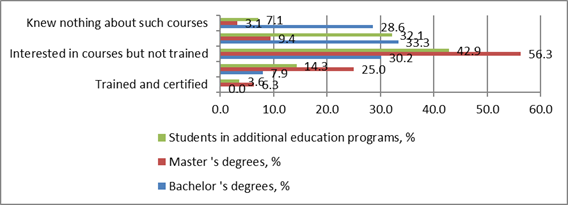
According to the responses, the highest awareness about online courses was shown by graduate students and students of continuing education (3.1 and 7.1 %, respectively). It is explained by the fact that respondents from these groups more often considered and studied proposals of distance education, including those from private companies, that widely use modern network-based technologies of distance education. The largest share of respondents in all groups stated their interest in MOOCs – with graduate students being the most interested at 56.3 %, while for continuing education students this value was at 42.9 %. The number of respondents with previous experience of studying in a MOOC is very low, only 3 persons, amounting to 2.4 % of those surveyed. Comparing the obtained data with averaged values of MOOC currency among students of regular Russian universities in 2016, it may be stated that pervasiveness of online courses among regional students is still low ( Harden, 2014; Liyanagunawardena, 2016; Roshchina et al., 2018).
The next question concerned motivation for learning in the form of an online course. When answering this question, respondents could select several variants simultaneously. The results are shown in Figure
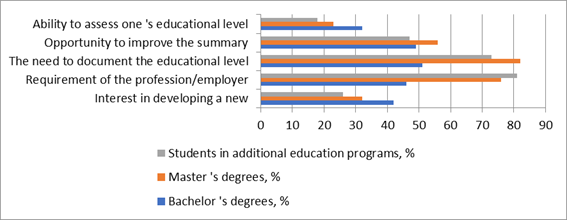
For all the groups, answers to this question demonstrate prevalence of motivation related to formal requirements: the first positions were taken by a necessity of documented proof of course completion, employer requirements and possibility to include information about completed courses into one’s resume. It witnesses to a high demand among the potential participants for obtaining recognizable formal certification to be subsequently used in one’s professional activities.
At the next stage of the survey, it was deemed interesting to explore, which characteristics of electronic courses are deemed as significant by their prospective participants, thus allowing for some deductions about factors influencing MOOC selection. Answers to this question will allow refining a list of characteristics requiring special attention in course development. In this question, respondents were asked to assess listed factors on a ten-point scale (Figure
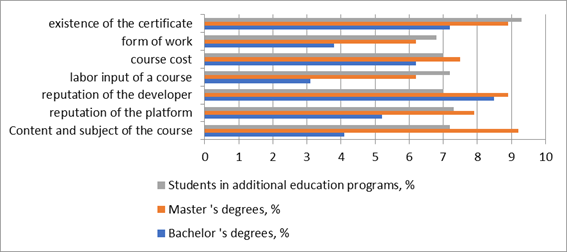
Analyzing the course selection factors, it is practical to point at the factors deemed most important by each of the groups of respondents. For undergraduate students, the most important factors were developer’s reputation (average assessment 8.25), availability of certification (average assessment 7.2), cost (average assessment 6.2). It shows that undergraduate students are primarily interested in obtaining a certificate from a well-known educational institution by means of distance learning.
As for graduate students, for them most important were content and topic of the course (average assessment 9.2), as well as developer’s reputation and availability of certification (average assessments of 8.9 for both). It is explained by this group having deeper professional interests, well-developed motivation and professional sense of purpose. For students of continuing education programs, availability of certification is essential (average assessment 9.3), the rest of factors received approximately equal assessments.
Then, it was necessary to identify obstacles that could potentially inhibit respondents’ learning in the MOOC format. Assessment of listed obstacles also followed the ten-point scale (Figure
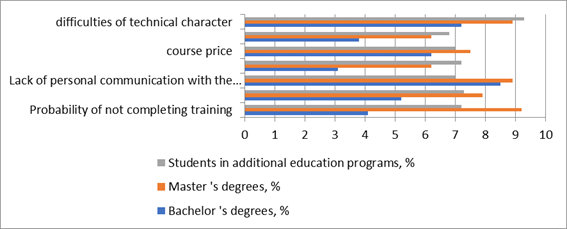
The results of the survey show that for undergraduate students, the most significant obstacle is the lack of personal contact with instructor (average assessment 8,5), as well as technical difficulties (such as low level of computer competence, lack of special software, Internet connection issues, etc.). – average assessment 7.2. The lack of personal contact with the instructor is also important for graduate students (average assessment 8.9), as is a fear of non-completing the course (average assessment 9.2). Students of continuing education programs see main obstacles in technical difficulties and probability of non-completing the course (average assessments 9.3 and 9.5, respectively).
Then, the authors deemed it interesting to establish, what model of the MOOC use in university education the potential participant hold as the most efficient. The answer to this question supplied the following variants, formed on the basis of Methodological recommendations for inclusion of online courses into curricula of the National Association of Open Education:
substitution of a single subject with a MOOC (e.g., for narrow-focused courses);
implementation of a blended learning model, combining traditional lessons with electronic courses (this variant assumes reduction in class hours by means of increased independent work of students);
using a model assuming MOOCs as additional resources.
Respondents were required to select only one variant. The results are shown in Figure
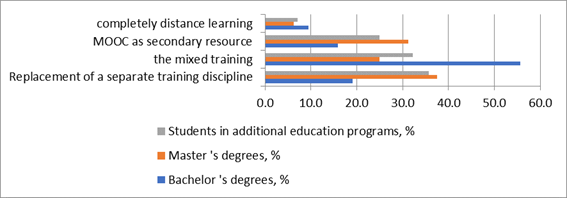
From the data obtained, it may be stated that undergraduate students deem blended learning (42.9 %) and substitution of a single subject (31.7 %) more acceptable. Graduate students were more interested in in substitution of a single subject (37.5 %) and using MOOC as an additional course (31.3%). Students of continuing education programs thought that the most appropriate variants are substitution of a single subject (27.6 %) and blended learning (42.9 %). Readiness to completely switch to MOOCs was demonstrated only by 9.5 % of undergraduates, 6.3 % of postgraduates and 7.1 % of students of continuing education programs.
In the end of the study, the authors tried to discover, how the respondents assess their own ability to study through open online courses. Practicality of this question is defined by the fact that mastering of an online course requires from students certain well-developed skills in organizing one’s independent work, namely:
information search skills;
skills in systematization and transformation of learning materials;
skills in formatting learning results in accordance with the requirements;
skills of time management in work with course materials;
skills of online communication.
The respondents self-evaluated for the listed skills on a ten-point scale; averages values are shown in Figure
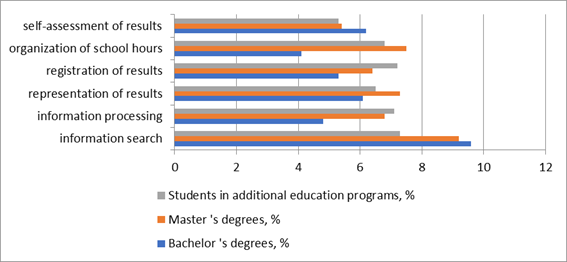
The results obtained show that all the groups of respondents evaluate their information search skills as the most developed (9.6 – average assessment by undergraduates and 9.2 – by graduate students). The most problematic skill for undergraduate students are those related to information processing (average assessment 5.4) and time management (average assessment 6.2). Graduate students evaluate their time management skills somewhat higher (average assessment 7.5); their information processing skills were self-evaluated at 6.8 on average. In all groups of respondents, the lowest scores were given for online communication skills (on average, this skill was estimated at 5.6).
Conclusion
The results obtained during the research allow refining and understanding characteristic features of potential online course participants.
First, an unquestionable fact is that a significant portion of educational process in universities will soon be delivered in the online course format. At that, awareness of potential participants, i.e., persons with a need in regular quality distance education with formal certification is still rather low in regional universities.
Second, the online courses being developed in continuing professional education shall have a formal confirmation of completion in the form of a certificate, as the ability to show such a certificate to one’s employer and confirm their professional level of expertise is the main reasons for distance learning named by most of the potential participants.
Third, the potential participants remain wary of exclusively distance education, linking possible issues to a lack of personal contact with the instructor, possible communication problems, insufficient development of information processing skills.
Fourth, the most acceptable model for the use of MOOCs in university educational process for the respondents is blended learning, where class exercises providing ability to consult with an instructor are supplemented with an ability to master a MOOC from an outside organization. Exclusively distance education is perceived as education of insufficiently high quality, where educational results may be fabricated and manipulated.
References
- Beloglazov, A. A., & Beloglazova, L. B. (2018). The use of mass open online courses as a way to improve the quality of teaching in the field of information technology. J. of Inform. in Ed. Vestn. RUDN. Ser. Inform. of Ed., 15(2), 206–214. https://doi.org.10.22363/2312-8631-2018-15-2-206-214
- Borisova, L. V. (2011). Problems of training teachers for work in the information and educational environment of distance learning with a remote contingent of university students. Vector of Sci., Togliatti State Univer., 4(7), 45–47.
- Bugaychuk, K.L. (2013). Mass open distance courses: history, typology, prospects. Higher ed. in Russ., 3, 148–155.
- Charushnikov, V. (2008). E-learning: pros and cons. Higher ed. in Russ., 12, 113–115.
- Elizarieva, Yu. A. (2016). Modern teacher in the process of “MOOKization” of education. Humanitarian Informatics, 10, 92–100. https://doi.org/10.17223 / 23046082/10/10
- Gruzdeva, M. L., Smirnova, Z. V., Chaikina, Z. V., Golubeva, O. V., & Cherney, O. T. (2018, April). Using internet services in teaching methodology. In International Conference Project “The future of the Global Financial System: Downfall of Harmony” (pp. 1193-1199). Springer, Cham.
- Harden, S. B. (2014). Transitional Disruption or End Times: The Apocalyptic Possibilities of MOOCs in Higher Education. Community Engagement 2.0? Dialogues on the Future of the Civic in the Disrupted University. Palgrave Macmillan.
- Hollands, F. (2014). Why Do Institutions Offer MOOCs? J. of Asynchronous Learn. Network, 18(3), 1–20.
- Ilyashenko, L. K., Markova, S. M., Mironov, A. G., Vaganova, O. I., & Smirnova, Z. V. (2019). Educational environment as a development resource for the learning process. Amazonia investiga, 8(18), 303-312.
- Liyanagunawardena, T. R (2016). Learners and Massive Open Online Courses: A Review Interactive. J. of Med. Res., 5(1). https://www.ncbi.nlm.nih.gov/pmc/articles/PMC4722228/
- Makoveychuk, K. A. (2015). Prospects for the use of courses in the MOOC format in higher education in Russia. Int. Sci. J., 6–3(37), 66–67.
- Markova, S. M., Poletaeva, N. M., & Cyplakova, S. A. (2016). Modeling of the educational technology of the training of the teacher of professional training. Vestnik Mininskogo universiteta, 1-1, 13.
- Pekker, P. L. (2018). Key professional competencies for teachers of mass open online courses (MOOK). Values and meanings, 1(53), 117–127.
- Popova, L. V., Marfenin, N. N., & Pekker, P. L. (2017). A Profile of Online Course Student.
- Roshchina, J., Roshchin, S., & Rudakov, V. (2018). Spros na massovye otkrytye onlayn-kursy (MOOC): opyt rossiyskogo obrazovaniya [The Demand for Massive Open Online Courses (MOOC): Evidence from Russian Education]. Voprosy obrazovaniya / Educational Studies Moscow, 1, 174-199.
- Semenova, T. V., Vilkova, K. A., & Scheglova, I. A (2018). The market for mass open online courses: prospects for Russia. Ed. Issues, 2, 173–180.
- Shah, B. (2018). The Numbers: MOOCs in 2018 Class Central. https://www.classcentral.com/report/mooc-stats-2018
- Smirnova, Z. V., Gruzdeva, M. L., & Krasikova, O. G. (2017). Open electronic courses in the educational activity of the university. Vestnik of Minin University, 4, 21.
- Tretyakov, V. S., & Larionova, V. A. (2016). Open online courses as a tool for the modernization of educational activities at a university. Higher Ed. in Russ., 7(203), 55–66.
- Zolotukhin, S. A. (2015). The advantages and disadvantages of mass open online courses. Discussion, 4(56), 97–101.
Copyright information

This work is licensed under a Creative Commons Attribution-NonCommercial-NoDerivatives 4.0 International License.
About this article
Publication Date
31 October 2020
Article Doi
eBook ISBN
978-1-80296-091-4
Publisher
European Publisher
Volume
92
Print ISBN (optional)
-
Edition Number
1st Edition
Pages
1-3929
Subjects
Sociolinguistics, linguistics, semantics, discourse analysis, translation, interpretation
Cite this article as:
Lebedeva, T. E., Prohorova, M. P., Egorov, E. E., Mineeva, O. A., & Golubeva, O. V. (2020). Studying Prospective Participants Of Open Online Cources. In D. K. Bataev (Ed.), Social and Cultural Transformations in the Context of Modern Globalism» Dedicated to the 80th Anniversary of Turkayev Hassan Vakhitovich, vol 92. European Proceedings of Social and Behavioural Sciences (pp. 2075-2084). European Publisher. https://doi.org/10.15405/epsbs.2020.10.05.273

